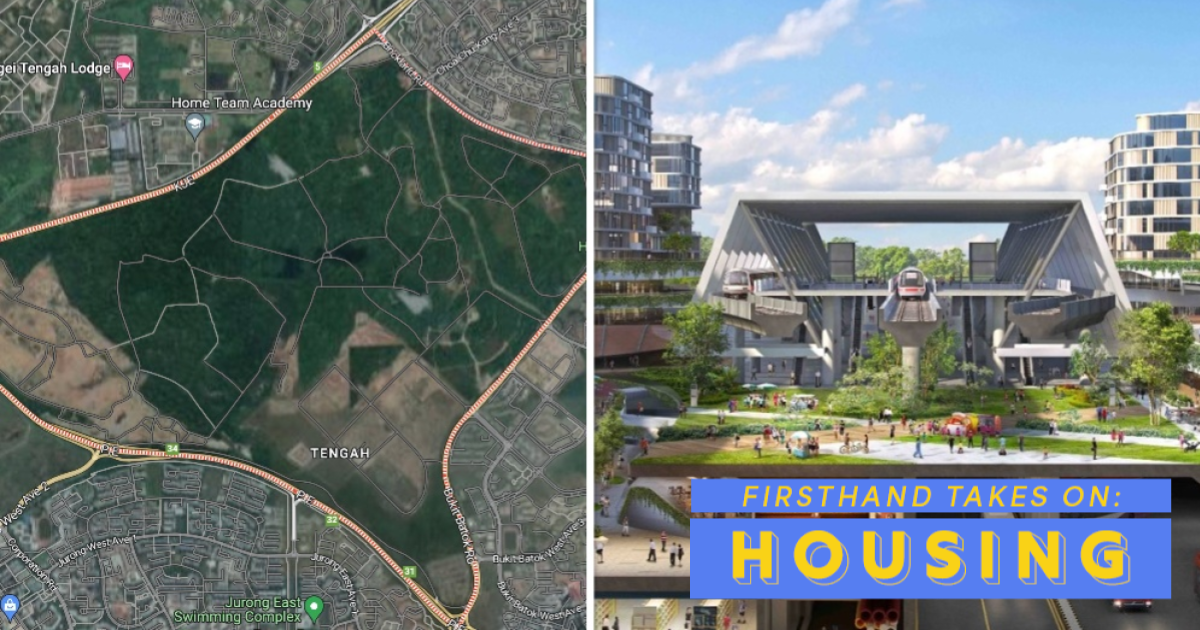Firsthand Takes On: Housing is a new series by Mothership, diving into the topic of housing in Singapore with in-depth articles and videos.
We’ll explore the uniquely Singaporean housing system by experiencing it for ourselves, gathering expert opinions, and hearing the perspectives of young Singaporeans, to present the points of view that matter, firsthand.
This is an aerial view of the Tengah airfield, sometime in the 1950s.
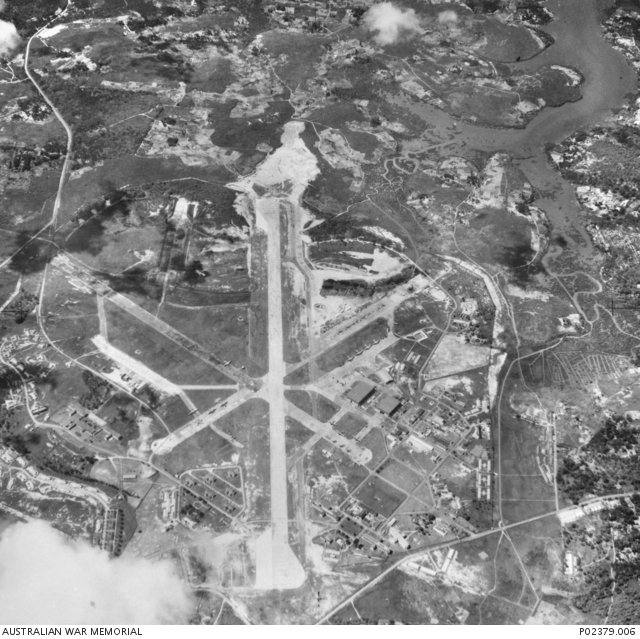 Photo courtesy of Australian War Memorial
Photo courtesy of Australian War Memorial
And this is Tengah in 2023.
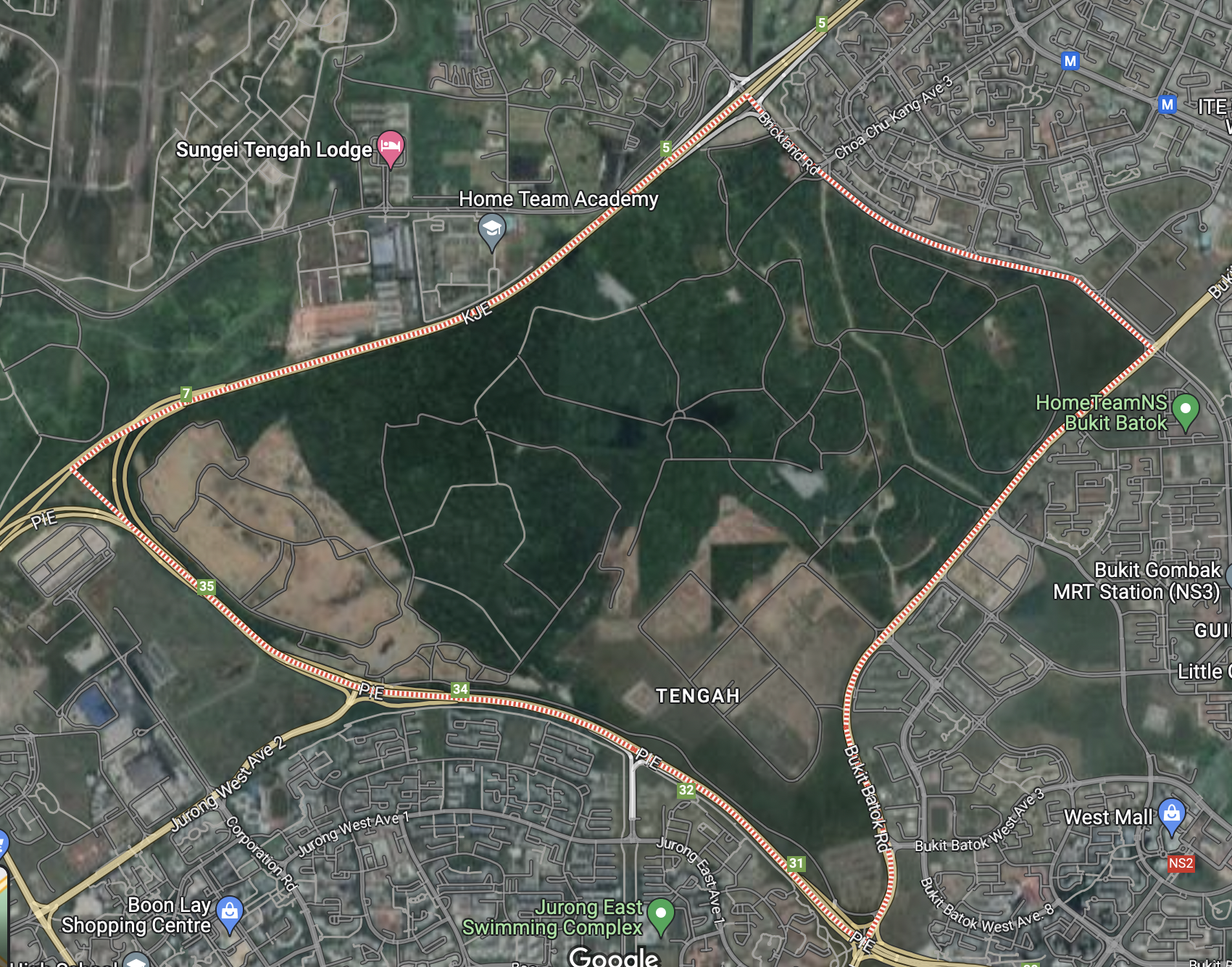 Nothing much but vast greenery and some ongoing residential developments. Image via Google Maps.
Nothing much but vast greenery and some ongoing residential developments. Image via Google Maps.
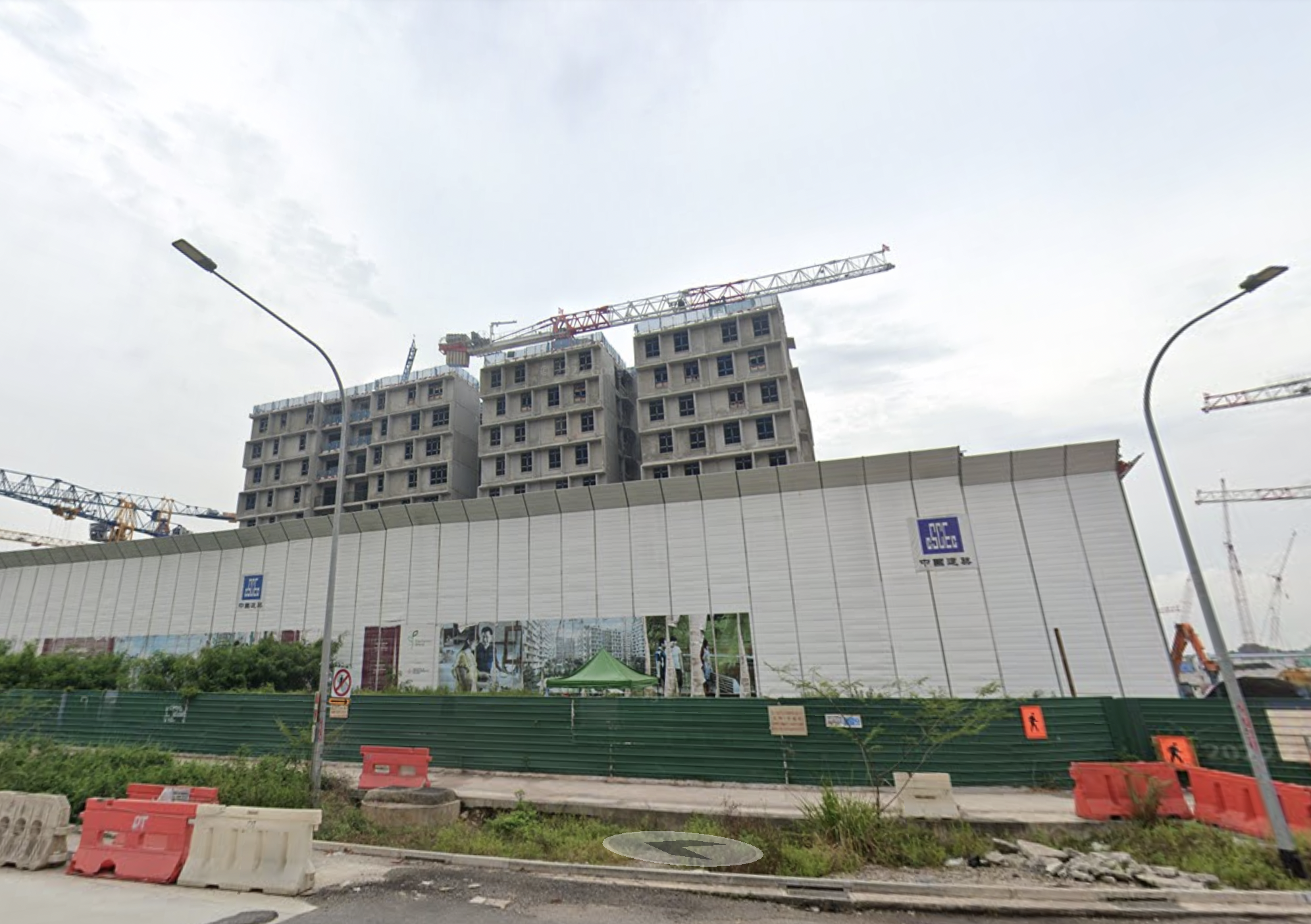 To be developed. Image via Google Maps Street View
To be developed. Image via Google Maps Street View
Once it is completed, Tengah is slated to look like a “forest town” of the future, a vision of modern “urban living”.
The new town will be developed with a biophilic framework, which basically means that Tengah’s HDB blocks, amenities, and roads will be designed around strong themes related to the forest and nature.
Literally, it will be easier than ever to stop and smell the roses (and get some fresh air).
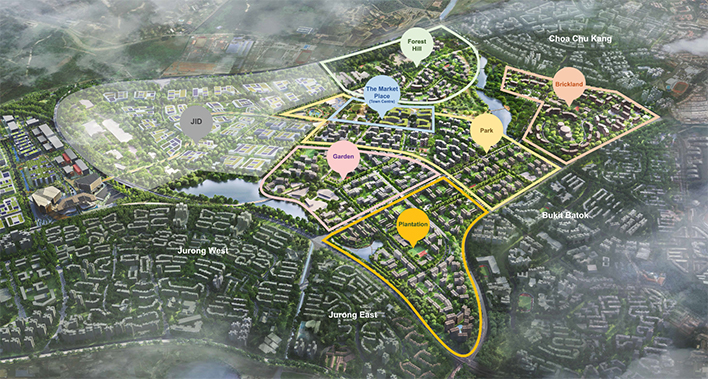 A forest fringe will run the entire town’s perimeter, and a 5km-long forest corridor will be built to run through the town. Image via HDB
A forest fringe will run the entire town’s perimeter, and a 5km-long forest corridor will be built to run through the town. Image via HDB
 Dedicated walking and cycling paths for “green commuting”. Image via HDB
Dedicated walking and cycling paths for “green commuting”. Image via HDB
In Tengah, there will be several shiny new amenities, such as a futuristic-looking car-free town centre and a massive Central Park, as well as transport nodes like the Jurong Region Line (JRL) and the Tengah Integrated Transport Hub.
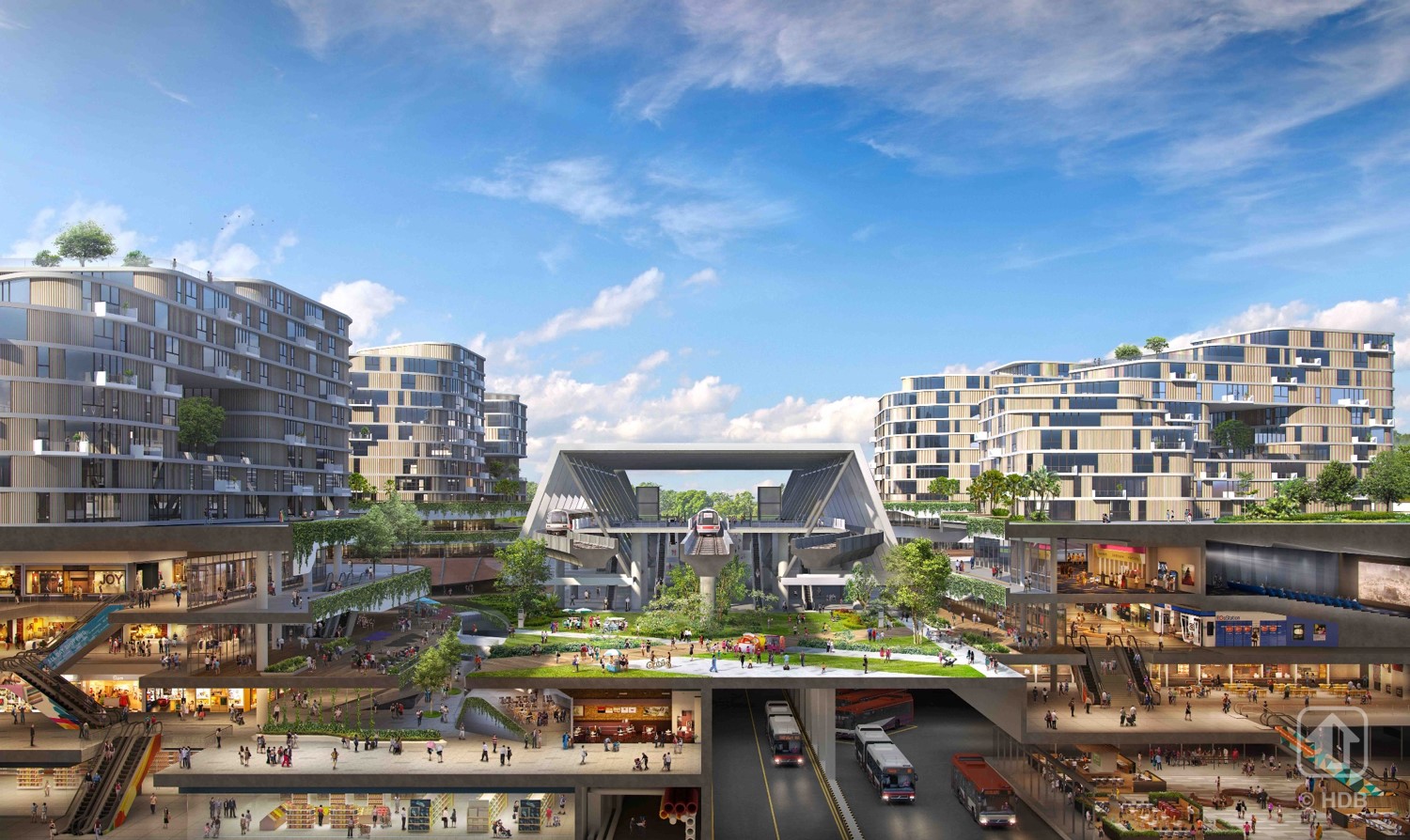 The car-free town centre will be developed such that the roads are planned for beneath the town centre. On the surface, pedestrian roads can then be freed up for walking, cycling and recreational activities. Image via HDB
The car-free town centre will be developed such that the roads are planned for beneath the town centre. On the surface, pedestrian roads can then be freed up for walking, cycling and recreational activities. Image via HDB
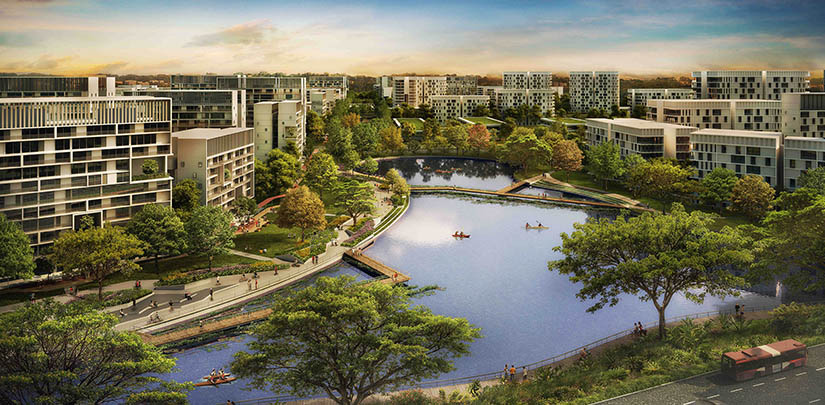 The town will also have its own Central Park, where there will be recreational areas like an amphitheatre and kayaking. Image via HDB
The town will also have its own Central Park, where there will be recreational areas like an amphitheatre and kayaking. Image via HDB
An estimated 42,000 homes will be built progressively across five districts in Tengah, MND told The Straits Times in Mar. 2023.
Most recently, Tengah received a fresh wave of interest from potential homebuyers, after news that Anglo-Chinese School (Primary) (ACS(P)), will be moving there in 2030, from its current location at Barker Road.
The upcoming May 2023 exercise at Tengah, in particular, is believed to be highly sought after as one of the projects will be located adjacent to ACS(P), while being close to the bus interchange and Tengah MRT station.
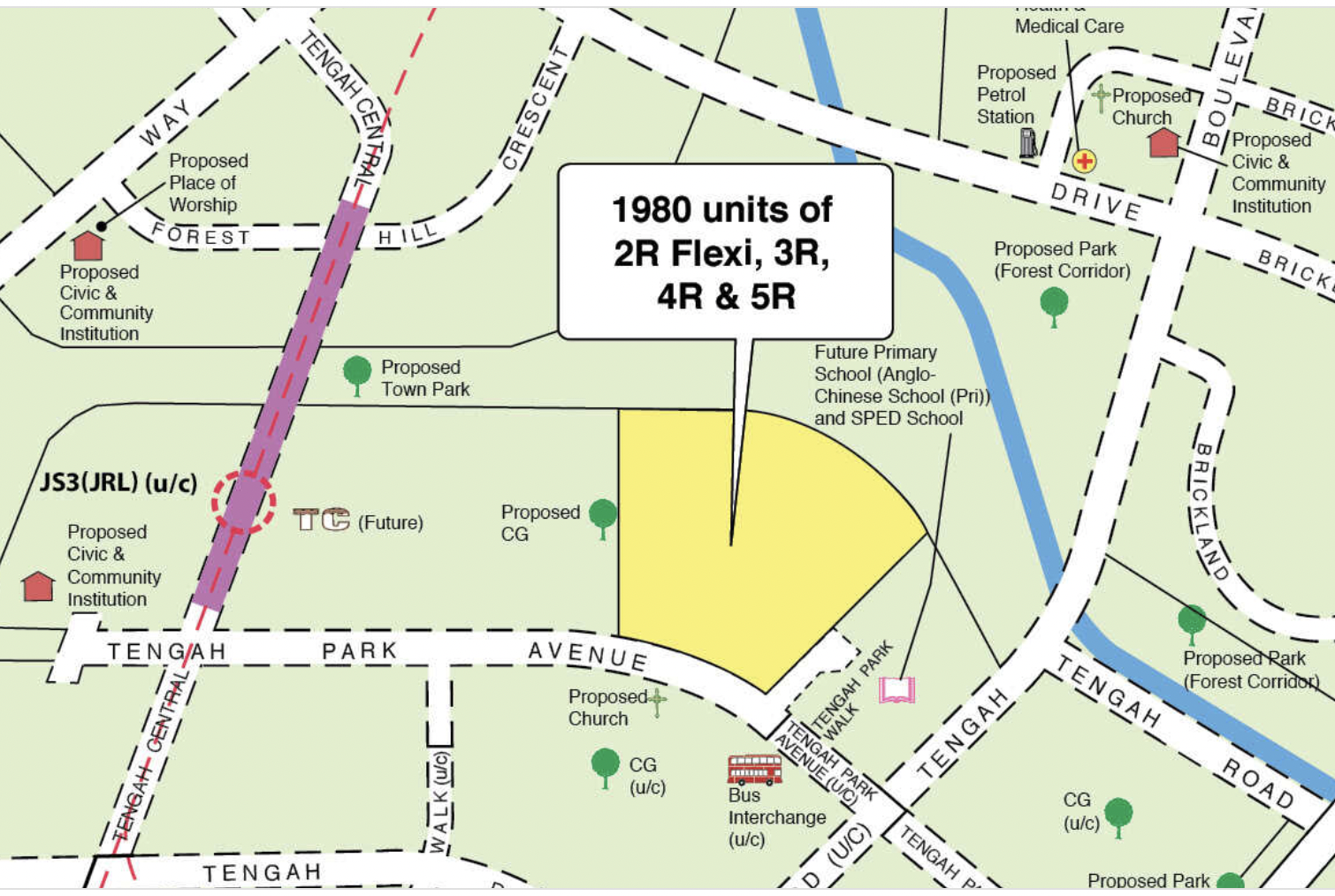 Image via HDB
Image via HDB
However, for now, there is admittedly nothing much at the 700-hectare plot of land, except for tangled green and a legion of tower cranes.
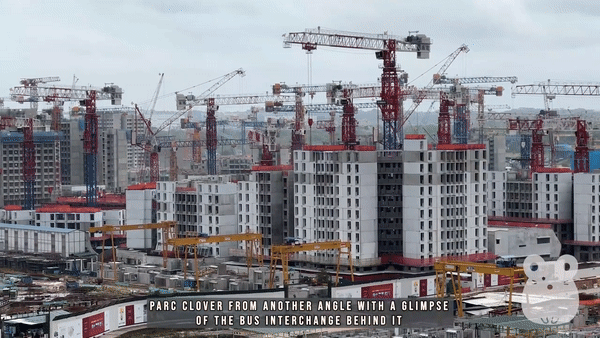 Tengah forest in the background, and construction for two ongoing BTO projects – Parc Glen and Parc Clover. GIF via Chasing Hams Explore YouTube.
Tengah forest in the background, and construction for two ongoing BTO projects – Parc Glen and Parc Clover. GIF via Chasing Hams Explore YouTube.
Much like its predecessors Punggol and Sengkang, it is likely that Tengah will take at least another decade to fully develop.
Whilst the first two crops of Tengah BTO flats are set to be completed by Q4 2023 and in 2024, transport infrastructure such as the Jurong Region Line is estimated to only open in stages from 2027.
A neighbourhood centre, as well as a new polyclinic is estimated to also open only in 2025, and it is still unclear when the car-free town centre and Central Park will be completed.
With construction barriers cordoning off the semi-constructed buildings, those who do ballot for Tengah are unable to head down and review the site’s suitability for themselves as easily.
Yet, despite the nascent stage of construction, soon-to-be residents and property analysts told us that Tengah is quite liveable, and shared why they are optimistic about the new town.
More often than not, what was brought up was Tengah’s “potential”.
Buying into the vision for the West
A homeowner surnamed Ong, 28, who successfully applied for a BTO project in Tengah on her third try, said it was a pragmatic choice to move to the estate despite having lived in the east her whole life.
Ong and her husband had chosen to do so as they wanted to live close to their in-laws, who live near the new town.
In fact, the couple had applied for Tengah’s first ever BTO project back in 2018, but did not get a unit, and decided to try again for the Plantation Acres project launched in 2019.
That most of their friends had later applied for a flat in Tengah and would be living close by was a plus; as according to Ong, Tengah is the “in thing” for those currently living in the West.
While waiting for their house to be completed – estimated to be in Q4 2023 – Ong, her husband and her five-month-old baby boy stay in Pasir Ris with her parents.
Although she will have to relocate from one end of Singapore to another, Ong shared that she has no qualms about the move or about living in Tengah, and her parents had also supported the decision.
The couple are content with their preliminary set of amenities; their future home is located near to the Le Quest shopping centre in Bukit Batok, with food courts and supermarkets within walking distance.
As car owners, the couple are also less fussed about travelling out of town, or having to make the approximately 35-minute drive every week to visit her parents after moving.
Ong added that she is also personally invested in Tengah’s development as an engineer working on sustainable buildings in the industry, and does not mind the wait.
Instead, she looks forward to seeing how her BTO and the estate will develop over the next decade – especially when it comes to the construction of the town’s car-lite features and each block’s Centralised Cooling system.
The Centralised Cooling system will be the first of its kind in any residential estate, and will trial a more cost effective way to provide residents with Singapore’s secret to success – air conditioning.
“It is interesting to see how it [the Centralised Cooling system] will affect me directly (as a user). It could be something I can help to propose to my clients in the future as well.”
A "better" Punggol in the West
Ong, who is also one of the admins of the Tengah BTO Telegram chat with over 5,700 members – an informal source of the estate’s latest developments for future residents – also highlighted an interesting trend.
Her observation is that many soon-to-be residents of Tengah are westies or similarly also have partners living in the west.
She added: “They [Those who balloted] expect and hope Tengah to be a ‘better’ Punggol.”
Within the chat, some further explained that Tengah is objectively less “ulu” than Punggol, and will offer access to amenities in neighbouring towns.
Others opined that Tengah’s planned amenities are comparable to Punggol’s, but brand new, and shared a belief that the new town would be rapidly developed once residents’ keys are collected.
Lee and Loh, both 28, who currently live in Choa Chu Kang and Sengkang respectively, elaborated more on the latter and why they believed in the higher powers that be.
While there were pragmatic considerations in selecting their BTO, such as price, build time, and proximity to the workplace, Loh quipped candidly that for him, another driving factor had simply been "faith" in the government’s ability to plan for the future.
Having moved in when the Sengkang estate was bounded by trees and shrubbery, Loh had witnessed firsthand the transformation of the Sengkang estate from untenable woodland to liveable concrete jungle.
“I think it gave me confidence that the timeline would be similar in the case of Tengah, and given the background of the estimated time of completion for the JRL and the estate, [I’m hoping] the functional stage of the town will be accelerated.”
In Sengkang, it had taken about five to six years for the North East Line and LRT stations to be completed, which had made travelling from the estate to the rest of Singapore a major hassle in the beginning.
After the transport infrastructure was completed, however, the malls, facilities, and amenities within the town had quickly become established. Loh added:
“The next 10 years or so were [then] bonuses that enhanced the lived experience – the meat so to say.”
Based on Loh’s lived experience, the couple estimate that the full development of Tengah may take up to 15 years – but it is a timeline they are okay with.
Another couple, James and Janet (not their real names), 28 and 26, said they were hopeful Tengah would flourish even faster with more advanced construction technology.
“We think it will take about 10 years (2030+) for Tengah to reach its full potential, factoring in the movement of ACS(P) and the completion of the Jurong Lake District.”
The couple added that the influx of more childcare centres and primary schools announced recently had changed their perspective on the new town’s long-term potential.
Instead of selling the flat after Tengah’s development is more complete, the couple are considering the value of staying on to raise their children there too.
The rise of the first-movers
Indeed, the mindset of homebuyers in Singapore has shifted over the years, shared a property agent with over 20 years of experience.
Micah Lim, Senior Associate Director of JKL Consultants, said that while there remains a proportion of individuals who wish to stay in mature estates, there has also been a rising number of homebuyers who prefer to be “first-movers” and start afresh in a new estate.
Having seen the successful development of similar ulu (remote) areas, such as Punggol and Sengkang, Singaporeans now have more confidence in the planning ability of the government.
“It [The distance/location of Tengah to the town centre] also poses less of a problem now than 10-20 years ago, with the development of the MRT and expressway network.”
The relative affordability of new towns such as Tengah, as well as the shorter building time as compared to flats in mature estates, is another major draw, added a senior analyst from One Global Group.
Mohan Sandrasegeran, 35, opined that Tengah is likely to be popular amongst young buyers who are looking for a more affordable BTO flat, and who do not mind waiting for the neighbourhood to develop.
 A comparison of the price point and waiting time for a four-room flat in Brickland Weave in Tengah estate compared to Rajah Summit in the Kallang/Whampoa estate for the Feb. 2023 exercise. Image via One Global Group, HDB.
A comparison of the price point and waiting time for a four-room flat in Brickland Weave in Tengah estate compared to Rajah Summit in the Kallang/Whampoa estate for the Feb. 2023 exercise. Image via One Global Group, HDB.
Potential home buyers who are patient with Tengah’s development stand to reap the benefits from the transformations that have been earmarked.
“As more urban transformations occur, it would essentially become more attractive to buyers as well.”
Concerns with inter-town connectivity
The few concerns from future buyers have more to do with Tengah’s inter-town connectivity, and less to do with its intra-town amenities.
Unlike Ong and her husband, neither Lee and Loh, nor James and Janet plan to own a car.
As such, both couples see the construction of the car-free town centre and car-lite precinct as beneficial and especially appealing features of the new town.
However, James and Janet admitted that they are taking a risk by betting on the availability of amenities by the time they move into Tengah – estimated to be during Q4 2026.
The BTO project that they applied for, Plantation Creek, is located near the Transit Priority Corridor (TPC) – which is part of the Land Transport Authority’s Master Plan 2040. But this does not yet have an estimated time of completion, although the future TPC is set to create dedicated bus lanes and bus-only roads for improved bus speeds and connectivity.
For Lee and Loh, who are waiting to select their unit for the Garden Waterfront project, the closest mode of transport will be the Hong Kah MRT station on the JRL.
Currently, four JRL stations are set to be built within Tengah town itself, and will connect to the East West Line via Jurong East and Boon Lay, and the North South Line via Jurong East and Choa Chu Kang.
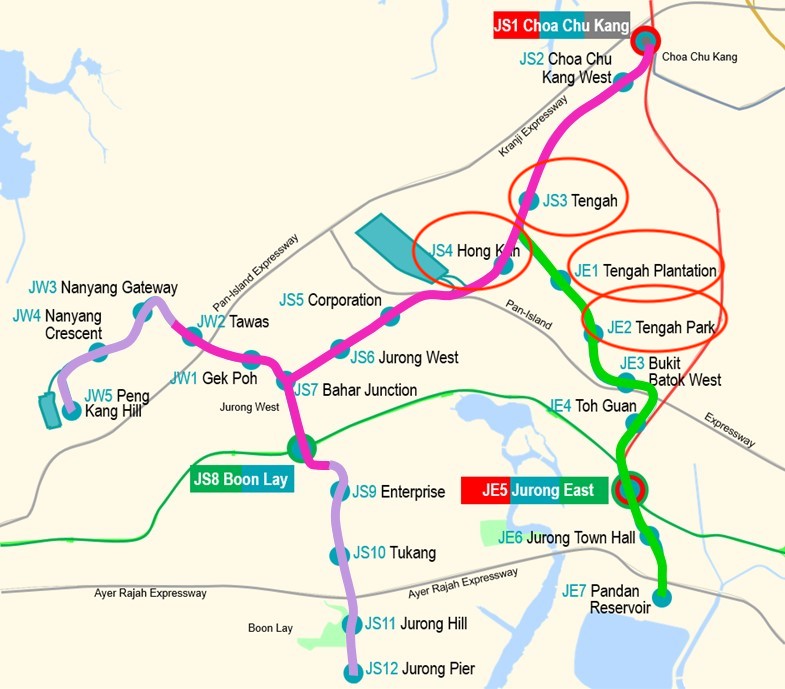 The new stations are expected to put Tengah’s residents within a 10-minute walk from an MRT station. According to HDB, bus stops will also be “situated within 300 metres of residential blocks” to help improve connectivity within Tengah and between towns. Image via LTA
The new stations are expected to put Tengah’s residents within a 10-minute walk from an MRT station. According to HDB, bus stops will also be “situated within 300 metres of residential blocks” to help improve connectivity within Tengah and between towns. Image via LTA
However, Lee and Loh shared candidly that they were hesitant about the “real effectiveness” of the JRL in making travelling to and from Tengah acceptable.
And according to Ong, other soon-to-be residents had also expressed similar reservations. Some raised doubts on the ease of transfer to nearby towns without a car, while others questioned the travelling time needed to more central areas for work.
In addition, while residents are mostly optimistic about the new features to come, Ong added that some had raised concerns about its implementation.
Ong cited the Centralised Cooling system as an example, and explained that details such as the exact cost savings, as well as the efficiency of the air conditioning, have not been made clear.
This may become teething issues that may lead to a situation like what one ex-Punggol resident faced after five years in the HDB town, which included heavy traffic (affecting both motorists and commuters), noisy neighbours (as a result of living close to many young families with kids), and noise pollution from a neighbouring airbase.
A tried-and-tested formula for success?
Still, it appears the general sentiment among future Tengah residents is generally positive.
Singapore is “liveable” because of how amenities that are important to residents are conveniently located on the town and neighbourhood level, shared Liu Thai Ker, the former chief architect of HDB and subsequent chief planner at URA.
This means that for the most part, basic infrastructure such as:
- An MRT and a public bus network,
- Proximity to expressways,
- Childcare centres and schools,
- Polyclinics, as well as
- Food and recreational options (e.g. malls)
will always be provided at the town level, to create self-sufficient new towns.
Done well, residents do not need to travel outside their specific HDB towns for work and daily living, which also reduces congestion in busier parts of a densely populated city.
Property agent Lim stated that Tengah, in that sense, is actually pretty “liveable”. This is because it is already situated close to several semi-matured estates that offer more developed amenities while the town is being built.
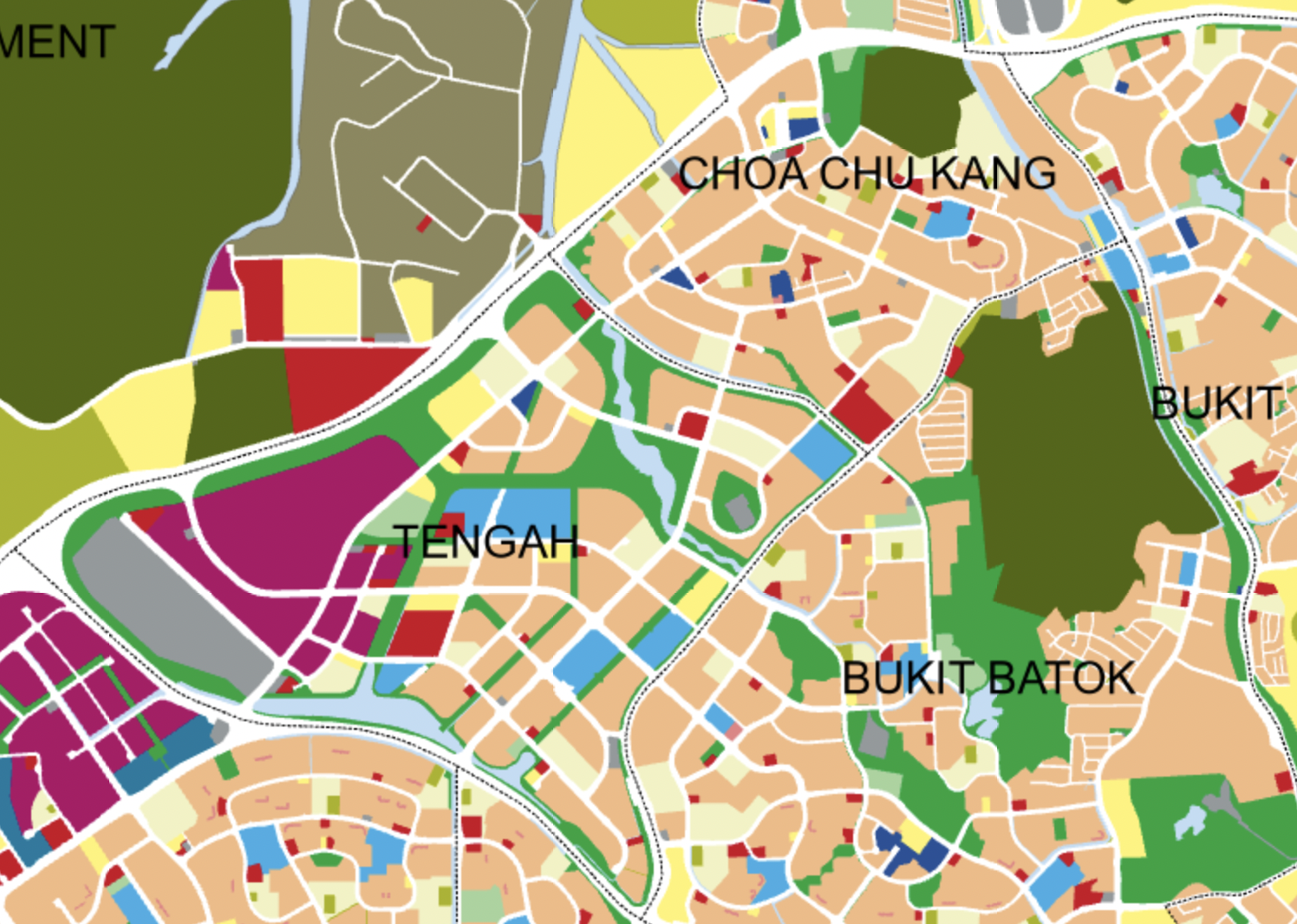 Tengah is bounded by Choa Chu Kang, which has Lot One, and Bukit Batok, which has West Mall. Image via URA
Tengah is bounded by Choa Chu Kang, which has Lot One, and Bukit Batok, which has West Mall. Image via URA
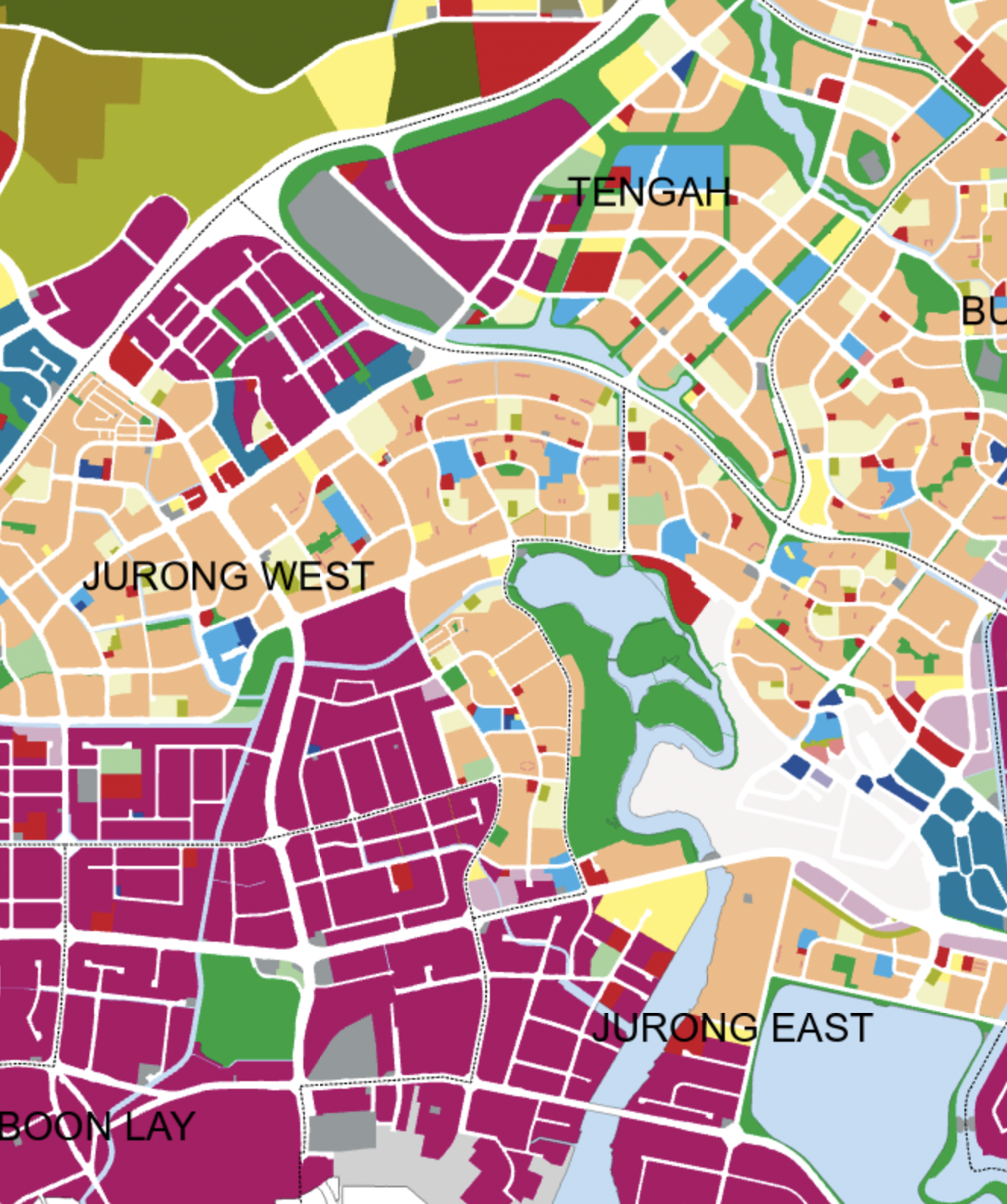 It is also located proximal to Jurong East, which has malls such as Westgate and IMM, and Jurong West. Image via URA
It is also located proximal to Jurong East, which has malls such as Westgate and IMM, and Jurong West. Image via URA
This is compared to Punggol in the early 2000s, when the closest mall was located in Serangoon.
Aside from good infrastructure, Mohan noted that a “liveable” HDB town should also offer residents a good quality of life, a sense of safety and security, and a strong sense of community.
Relocating a well-established institution such as ACS(P) to the up-and-coming town could also create a sense of familiarity and comfort in an “unfamiliar” area, said Mohan.
“This could potentially have a positive impact on the resale value of properties, making them more appealing to prospective buyers.”
Depending on the success of the Tengah HDB town, these elements will then likely be replicated for the construction of other new towns/plots of land that have been earmarked by the URA for redevelopment.
For example, the Paya Lebar Airbase.
Although it will only be relocated in the 2030s, URA has already revealed a plan for the plot’s redevelopment, and we can observe some similar elements within the upcoming new town, mainly: a transport system, amenities for work and play, car-free and pedestrianised neighbourhoods, as well as green corridors.
 Image via URA
Image via URA
An estimated 150,000 new homes are expected to be built where the former airbase currently sits.
It is also slated to be built with sustainable features, with plans for the former runway to be repurposed into a green connector or community space extending from end to end.
On the URA website, an old photo of the former Paya Lebar airport shows what it once was, before it fell out of commercial use.
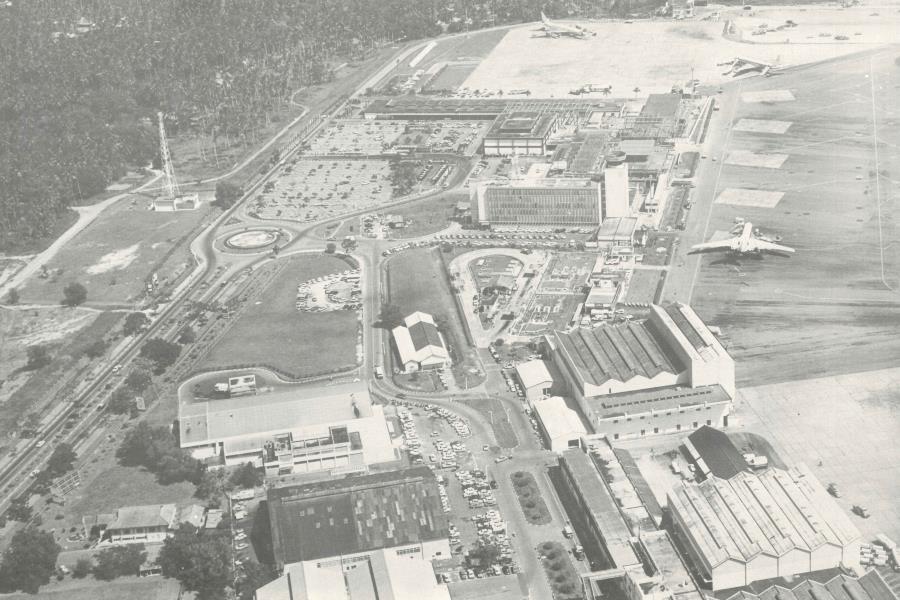 Former Paya Lebar airport. Image via CAAS via URA website
Former Paya Lebar airport. Image via CAAS via URA website
The storyline seems familiar, eh?
Top images via Google Maps Street View and HDB
If you like what you read, follow us on Facebook, Instagram, Twitter and Telegram to get the latest updates.
